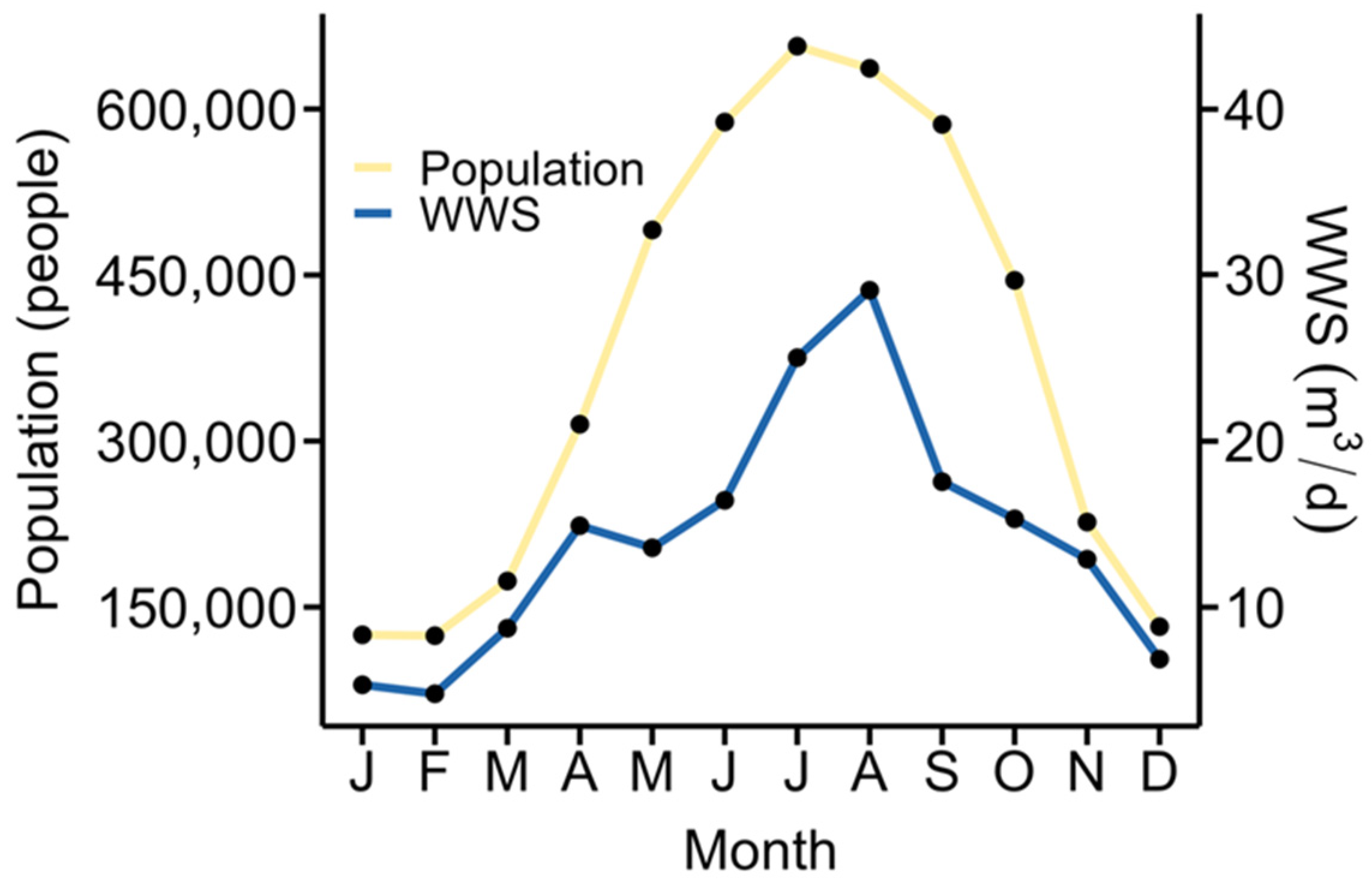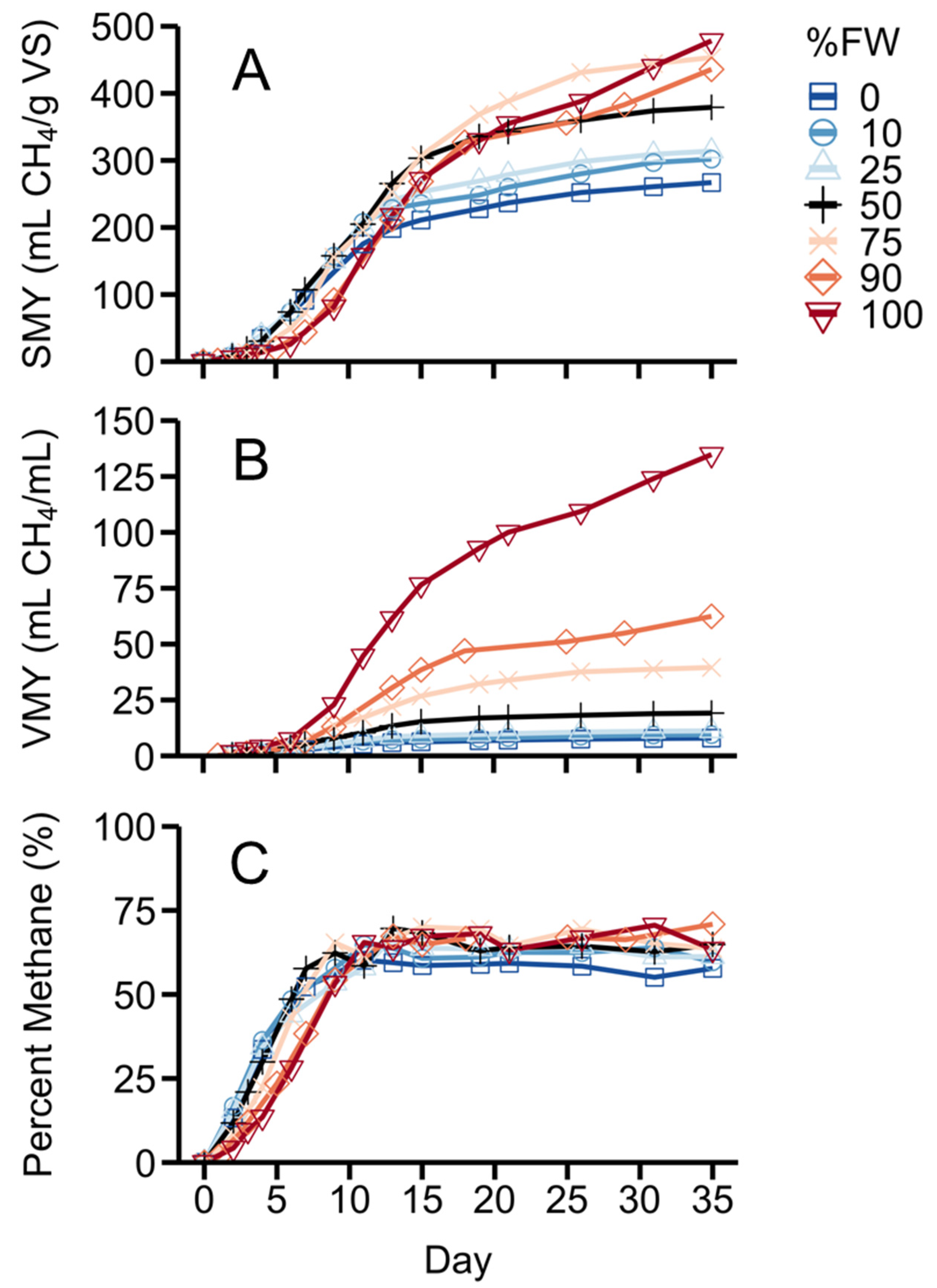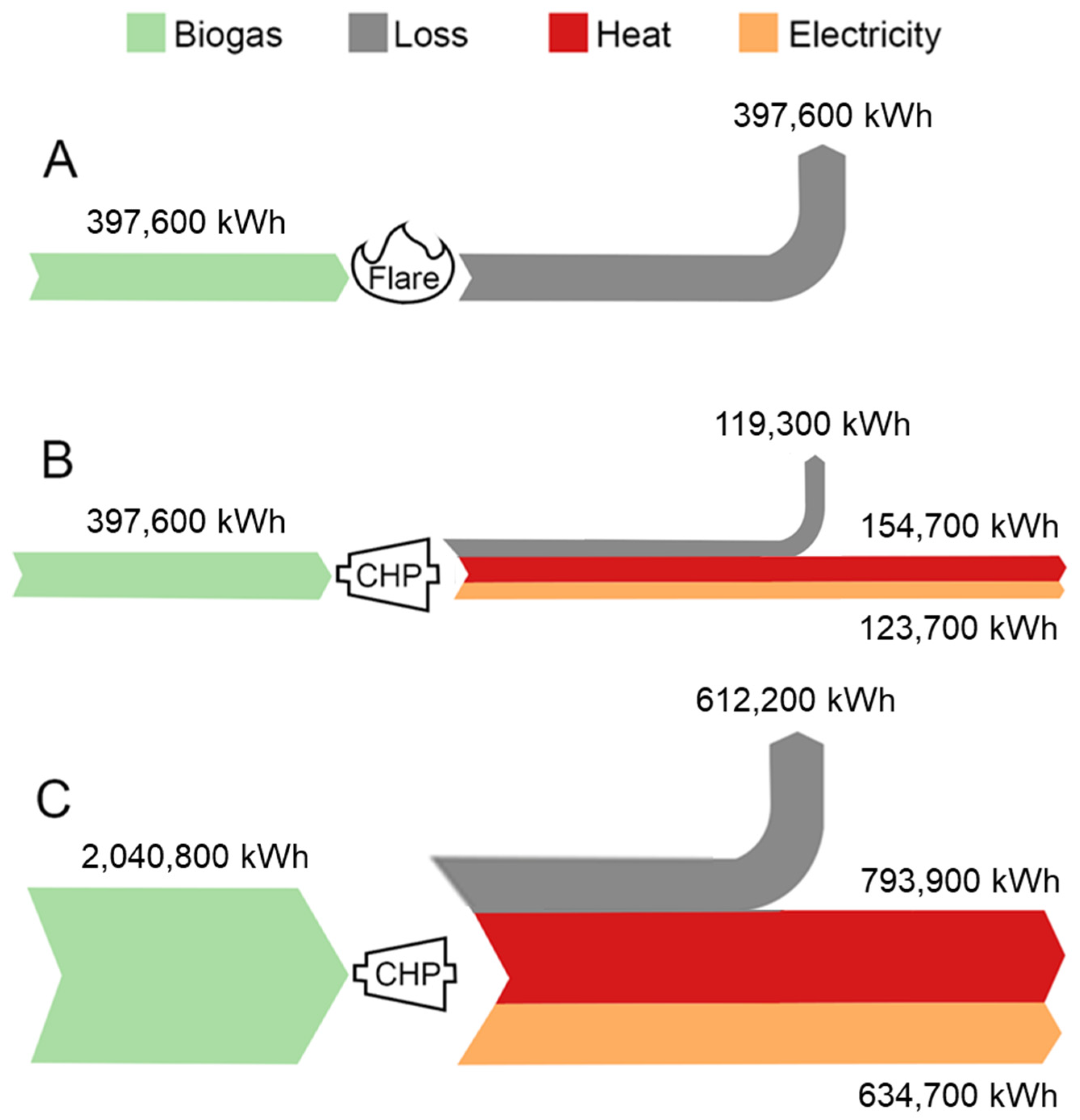Anaerobic Co-Digestion to Enhance Waste Management Sustainability at Yosemite National Park
Abstract
:1. Introduction
2. Materials and Methods
2.1. Study Site
2.2. Collection and Characterization of Waste
2.3. Biochemical Methane Potential
2.4. Analysis of Data
3. Results
3.1. Waste Characterization and Waste Production at Park
3.2. Biochemical Methane Potential
4. Discussion
4.1. Biochemical Methane Potential
4.2. Co-Digestion Energy Balance at the El Portal Wastewater Treatment Plant
4.3. Additional Considerations for Co-Digestion
5. Conclusions
Supplementary Materials
Author Contributions
Funding
Institutional Review Board Statement
Informed Consent Statement
Data Availability Statement
Acknowledgments
Conflicts of Interest
References
- Odum, H.T. Environment, Power, and Society for the Twenty-First Century; Columbia University Press: New York, NY, USA, 2007. [Google Scholar]
- Hoornweg, D.; Bhada-Tata, P. What a Waste: A Global Review of Solid Waste Management; World Bank: Washington, DC, USA, 2012. [Google Scholar]
- Appels, L.; Lauwers, J.; Degrve, J.; Helsen, L.; Lievens, B.; Willems, K.; Van Impe, J.; Dewil, R. Anaerobic Digestion in Global Bio-Energy Production: Potential and Research Challenges. Renew. Sustain. Energy Rev. 2011, 15, 4295–4301. [Google Scholar] [CrossRef]
- Braguglia, C.M.; Gallipoli, A.; Gianico, A.; Pagliaccia, P. Anaerobic Bioconversion of Food Waste into Energy: A Critical Review. Bioresour. Technol. 2018, 248, 37–56. [Google Scholar] [CrossRef]
- McCarty, P.L.; Bae, J.; Kim, J. Domestic Wastewater Treatment as a Net Energy Producer-Can This Be Achieved? Environ. Sci. Technol. 2011, 45, 7100–7106. [Google Scholar] [CrossRef] [PubMed]
- Satchwell, A.J.; Scown, C.D.; Smith, S.J.; Amirebrahimi, J.; Jin, L.; Kirchstetter, T.W.; Brown, N.J.; Preble, C.V. Accelerating the Deployment of Anaerobic Digestion to Meet Zero Waste Goals. Environ. Sci. Technol. 2018, 52, 13663–13669. [Google Scholar] [CrossRef] [PubMed]
- Guven, H.; Ersahin, M.E.; Dereli, R.K.; Ozgun, H.; Isik, I.; Ozturk, I. Energy Recovery Potential of Anaerobic Digestion of Excess Sludge from High-Rate Activated Sludge Systems Co-Treating Municipal Wastewater and Food Waste. Energy 2019, 172, 1027–1036. [Google Scholar] [CrossRef]
- Mehariya, S.; Patel, A.K.; Obulisamy, P.K.; Punniyakotti, E.; Wong, J.W. Co-digestion of food waste and sewage sludge for methane production: Current status and perspective. Bioresour. Technol. 2018, 265, 519–531. [Google Scholar] [CrossRef]
- Tchobanoglous, G.; Stensel, H.D.; Tsuchihashi, R. (Eds.) Metcalf and Eddy Wastewater Engineering: Treatment and Resource Recovery, 5th ed.; McGraw Hill Education: New York, NY, USA, 2014. [Google Scholar]
- Shen, Y.; Linville, J.L.; Urgun-Demirtas, M.; Mintz, M.M.; Snyder, S.W. An Overview of Biogas Production and Utilization at Full-Scale Wastewater Treatment Plants (WWTPs) in the United States: Challenges and Opportunities towards Energy-Neutral WWTPs. Renew. Sustain. Energy Rev. 2015, 50, 346–362. [Google Scholar] [CrossRef]
- Nghiem, L.D.; Koch, K.; Bolzonella, D.; Drewes, J.E. Full Scale Co-Digestion of Wastewater Sludge and Food Waste: Bottlenecks and Possibilities. Renew. Sustain. Energy Rev. 2017, 72, 354–362. [Google Scholar] [CrossRef]
- Macintosh, C.; Astals, S.; Sembera, C.; Ertl, A.; Drewes, J.E.; Jensen, P.D.; Koch, K. Successful strategies for increasing energy self-sufficiency at Grüneck wastewater treatment plant in Germany by food waste co-digestion and improved aeration. Appl. Energy 2019, 242, 797–808. [Google Scholar] [CrossRef]
- American Society of Civil Engineers (ASCE). 2017 Infrastructure Report Card: Wastewater; American Society of Civil Engineers: Washington, DC, USA, 2017. [Google Scholar]
- Xu, R.; Zhang, K.; Liu, P.; Khan, A.; Xiong, J.; Tian, F.; Li, X. A Critical Review on the Interaction of Substrate Nutrient Balance and Microbial Community Structure and Function in Anaerobic Co-Digestion. Bioresour. Technol. 2018, 247, 1119–1127. [Google Scholar] [CrossRef]
- Powell, J.T.; Townsend, T.G.; Zimmerman, J.B. Estimates of Solid Waste Disposal Rates and Reduction Targets for Landfill Gas Emissions. Nat. Clim. Chang. 2016, 6, 162–165. [Google Scholar] [CrossRef]
- Rasi, S.; Veijanen, A.; Rintala, J. Trace Compounds of Biogas from Different Biogas Production Plants. Energy 2007, 32, 1375–1380. [Google Scholar] [CrossRef]
- Swain, B. Waste to Fuel Program—City of Manteca WQCF. Presentation at the U.C. Merced Biogas Workshop, Merced, CA, USA. Available online: https://ucmerced.app.box.com/v/citrisbiogas2019 (accessed on 12 November 2019).
- National Park Service (NPS) Zero Landfill Initiative. Available online: https://www.nps.gov/yose/getinvolved/zlf.htm (accessed on 1 December 2019).
- Moody, L.B.; Burns, R.T.; Bishop, G.; Sell, S.T.; Spajic, R. Using Biochemical Methane Potential Assays to Aid in Co-Substrate Selection for Co-Digestion. Appl. Eng. Agric. 2011, 27, 433–440. [Google Scholar] [CrossRef]
- Raposo, F.; De La Rubia, M.A.; Fernández-Cegrí, V.; Borja, R. Anaerobic Digestion of Solid Organic Substrates in Batch Mode: An Overview Relating to Methane Yields and Experimental Procedures. Renew. Sustain. Energy Rev. 2012, 16, 861–877. [Google Scholar] [CrossRef]
- Montecchio, D.; Astals, S.; Di Castro, V.; Gallipoli, A.; Gianico, A.; Pagliaccia, P.; Piemonte, V.; Rossetti, S.; Tonanzi, B.; Braguglia, C.M. Anaerobic Co-Digestion of Food Waste and Waste Activated Sludge: ADM1 Modelling and Microbial Analysis to Gain Insights into the Two Substrates’ Synergistic Effects. Waste Manag. 2019, 97, 27–37. [Google Scholar] [CrossRef] [PubMed]
- Holliger, C.; Alves, M.; Andrade, D.; Angelidaki, I.; Astals, S.; Baier, U.; Bougrier, C.; Buffière, P.; Carballa, M.; De Wilde, V.; et al. Towards a Standardization of Biomethane Potential Tests. Water Sci. Technol. 2016, 74, 2515–2522. [Google Scholar] [CrossRef]
- MidAtlantic Solid Waste Consultants. Waste Characterization Study, Yosemite National Park; Draft Report to the National Parks Conservation Association, Washington, DC, USA; MidAtlantic Solid Waste Consultants: Orlando, FL, USA, 2015. [Google Scholar]
- American Public Health Association (APHA). Standard Methods for the Examination of Water and Wastewater, 21st ed.; American Public Health Association: Washington, DC, USA, 2005. [Google Scholar]
- Lisboa, M.S.; Lansing, S. Characterizing Food Waste Substrates for Co-Digestion through Biochemical Methane Potential (BMP) Experiments. Waste Manag. 2013, 33, 2664–2669. [Google Scholar] [CrossRef]
- Sundberg, C.; Franke-Whittle, I.H.; Kauppi, S.; Yu, D.; Romantschuk, M.; Insam, H.; Jönsson, H. Characterization of Source-Separated Household Waste Intended for Composting. Bioresour. Technol. 2011, 102, 2859–2867. [Google Scholar] [CrossRef]
- Holliger, C.; de Laclos, H.F.; Hack, G. Methane Production of Full-Scale Anaerobic Digestion Plants Calculated from Substrate’s Biomethane Potentials Compares Well with the One Measured on-Site. Front. Energy Res. 2017, 5, 1–9. [Google Scholar] [CrossRef]
- Zhang, R.; El-Mashad, H.M.; Hartman, K.; Wang, F.; Liu, G.; Choate, C.; Gamble, P. Characterization of Food Waste as Feedstock for Anaerobic Digestion. Bioresour. Technol. 2007, 98, 929–935. [Google Scholar] [CrossRef]
- Kim, H.W.; Han, S.K.; Shin, H.S. The optimization of food waste addition as a co-substrate in anaerobic digestion of sewage sludge. Waste Manag. Res. 2003, 21, 515–526. [Google Scholar] [CrossRef] [PubMed]
- Dai, X.; Duan, N.; Dong, B.; Dai, L. High-Solids Anaerobic Co-Digestion of Sewage Sludge and Food Waste in Comparison with Mono Digestions: Stability and Performance. Waste Manag. 2012, 33, 308–316. [Google Scholar] [CrossRef] [PubMed]
- Gu, J.; Liu, R.; Cheng, Y.; Stanisavljevic, N.; Li, L.; Djatkov, D.; Peng, X.; Wang, X. Anaerobic Co-Digestion of Food Waste and Sewage Sludge under Mesophilic and Thermophilic Conditions: Focusing on Synergistic Effects on Methane Production. Bioresour. Technol. 2020, 301, 122765. [Google Scholar] [CrossRef] [PubMed]
- Sosnowski, P.; Klepacz-Smolka, A.; Kaczorek, K.; Ledakowicz, S. Kinetic investigations of methane co-fermentation of sewage sludge and organic fraction of municipal solid wastes. Bioresour. Technol. 2008, 99, 5731–5737. [Google Scholar] [CrossRef] [PubMed]
- Raposo, F.; Fernández-Cegrí, V.; de la Rubia, M.A.; Borja, R.; Béline, F.; Cavinato, C.; Demirer, G.; Fernández, B.; Fernández-Polanco, M.; Frigon, J.C.; et al. Biochemical Methane Potential (BMP) of Solid Organic Substrates: Evaluation of Anaerobic Biodegradability Using Data from an International Interlaboratory Study. J. Chem. Technol. Biotechnol. 2011, 86, 1088–1098. [Google Scholar] [CrossRef]
- Izumi, K.; Okishio, Y.K.; Nagao, N.; Niwa, C.; Yamamoto, S.; Toda, T. Effects of Particle Size on Anaerobic Digestion of Food Waste. Int. Biodeterior. Biodegrad. 2010, 64, 601–608. [Google Scholar] [CrossRef]
- Prabhu, M.S.; Mutnuri, S. Anaerobic co-digestion of sewage sludge and food waste. Waste Manag. Res. 2016, 34, 307–315. [Google Scholar] [CrossRef]
- Elbeshbishy, E.; Nakhla, G.; Hafez, H. Biochemical Methane Potential (BMP) of Food Waste and Primary Sludge: Influence of Inoculum Pre-Incubation and Inoculum Source. Bioresour. Technol. 2012, 110, 18–25. [Google Scholar] [CrossRef]
- United States Department of Energy (USDOE). Combined Heat and Power Technology Fact Sheet Series; United States Department of Energy: Washington, DC, USA, 2017.
- United States Environmental Protection Agency (USEPA). Opportunities for Combined Heat and Power at Wastewater Treatment Facilities: Market Analysis and Lessons from the Field; United States Environmental Protection Agency: Washington, DC, USA, 2014; Volume 2012.
- Xu, F.; Li, Y.; Ge, X.; Yang, L.; Li, Y. Anaerobic Digestion of Food Waste—Challenges and Opportunities. Bioresour. Technol. 2018, 247, 1047–1058. [Google Scholar] [CrossRef]
- Schievano, A.; Tenca, A.; Scaglia, B.; Merlino, G.; Rizzi, A.; Daffonchio, D.; Oberti, R.; Adani, F. Two-stage vs single-stage thermophilic anaerobic digestion: Comparison of energy production and biodegradation efficiencies. Environ. Sci. Technol. 2012, 46, 8502–8510. [Google Scholar] [CrossRef]
- Baldi, F.; Pecorini, I.; Iannelli, R. Comparison of single-stage and two-stage anaerobic co-digestion of food waste and activated sludge for hydrogen and methane production. Renew. Energy 2019, 143, 1755–1765. [Google Scholar] [CrossRef]
- Karki, R.; Chuenchart, W.; Surendra, K.C.; Shrestha, S.; Raskin, L.; Sung, S.; Hashimoto, A.; Khanal, S.K. Anaerobic co-digestion: Current status and perspectives. Bioresour. Technol. 2021, 330, 125001. [Google Scholar] [CrossRef] [PubMed]
- Joo, S.H.; Dello Monaco, F.; Antmann, E.; Chorath, P. Sustainable Approaches for Minimizing Biosolids Production and Maximizing Reuse Options in Sludge Management: A Review. J. Environ. Manag. 2015, 158, 133–145. [Google Scholar] [CrossRef] [PubMed]
- Benn, N.; Zitomer, D. Pretreatment and Anaerobic Co-Digestion of Selected PHB and PLA Bioplastics. Front. Environ. Sci. 2018, 5, 1–9. [Google Scholar] [CrossRef]
- Krause, M.J.; Townsend, T.G. Life-Cycle Assumptions of Landfilled Polylactic Acid Underpredict Methane Generation. Environ. Sci. Technol. Lett. 2016, 3, 166–169. [Google Scholar] [CrossRef]
- Kafle, G.K.; Chen, L. Comparison on Batch Anaerobic Digestion of Five Different Livestock Manures and Prediction of Biochemical Methane Potential Using Different Statistical Models. Waste Manag. 2016, 48, 492–502. [Google Scholar] [CrossRef]
- Singhvi, M.S.; Kim, B.S. Current developments in lignocellulosic biomass conversion into biofuels using nanobiotechology approach. Energies 2020, 13, 5300. [Google Scholar] [CrossRef]
- Singhvi, M.S.; Kim, B.S. Lignin valorization using biological approach. Biotechnol. Appl. Biochem. 2021, 68, 459–468. [Google Scholar] [CrossRef]



| Co-Digestion Feed Stock | Select Treatments (% VS) | Specific Methane Yield (mL CH4/g VS) | Citation |
|---|---|---|---|
| Wastewater Solids and Food Waste | 0% food waste 50% food waste 100% food waste | 267 379 478 | This Study |
| Manure and Food Waste | 100% manure 19% manure, 81% cranberry 16% manure, 84% chicken | 92 200 381 | [25] |
| Wastewater Solids and Food Waste | 0% food waste 50% food waste 80% food waste | 116 215 257 | [29] |
| Wastewater Solids and Food Waste | 0% food waste 53% food waste 100% food waste | 237 350 465 | [30] |
| Wastewater Solids and Food Waste | 0% food waste 50% food waste 100% food waste | 285 410 520 | [31] |
Publisher’s Note: MDPI stays neutral with regard to jurisdictional claims in published maps and institutional affiliations. |
© 2022 by the authors. Licensee MDPI, Basel, Switzerland. This article is an open access article distributed under the terms and conditions of the Creative Commons Attribution (CC BY) license (https://creativecommons.org/licenses/by/4.0/).
Share and Cite
Burmistrova, J.; Beutel, M.; Hestir, E.; Ryals, R.; Pandey, P. Anaerobic Co-Digestion to Enhance Waste Management Sustainability at Yosemite National Park. Sustainability 2022, 14, 11877. https://doi.org/10.3390/su141911877
Burmistrova J, Beutel M, Hestir E, Ryals R, Pandey P. Anaerobic Co-Digestion to Enhance Waste Management Sustainability at Yosemite National Park. Sustainability. 2022; 14(19):11877. https://doi.org/10.3390/su141911877
Chicago/Turabian StyleBurmistrova, Julia, Marc Beutel, Erin Hestir, Rebecca Ryals, and Pramod Pandey. 2022. "Anaerobic Co-Digestion to Enhance Waste Management Sustainability at Yosemite National Park" Sustainability 14, no. 19: 11877. https://doi.org/10.3390/su141911877
APA StyleBurmistrova, J., Beutel, M., Hestir, E., Ryals, R., & Pandey, P. (2022). Anaerobic Co-Digestion to Enhance Waste Management Sustainability at Yosemite National Park. Sustainability, 14(19), 11877. https://doi.org/10.3390/su141911877






